Leveraging Reed Bed Burnings as Indicators of Wetland Conversion in Modern Greece
Abstract
:1. Introduction
- What is the spatial distribution and magnitude of reed bed fires in Greece between 2000 and 2022?
- Is it feasible to construct pyrogeographic maps of high resolution for reed beds?
- Are there specific land-cover types, such as permanent irrigated land and areas with complex cultivation patterns, that exhibit a high frequency of recorded reed bed fires?
- How does the historical context of land conversion initiatives in land-reclaimed areas relate to the current distribution of reed bed fires?
2. Materials and Methods
2.1. Terminology
2.2. Phragmites australis (Common Reed): Traits and Reed Bed Burnings
2.3. Reed Bed Burnings as Mediators for Inference of Wetland Distribution
2.4. Fire Statistics in Greece
2.5. Large Wetland Reclamation Works in Greece (1830–1960)
2.6. Indexes, Hypotheses, and Statistics
3. Results
3.1. General Description of the Reed-Bed-Fire Phenomenon
3.2. Comparison of Wildfire Severity Indexes vs. Agricultural Burnings
3.3. Stationarity of Reed-Bed-Burning Time Series
3.4. Time Series Analysis, Periodograms, and Spectral Analysis in Reed-Bed-Burning SI Series
3.5. Spatial Patterns of Reed Bed Burnings
4. Discussion
- Ecological Repercussions: while mainly affecting the keystone indicator species, reed bed burning impacts the broader wetland ecosystem. It influences the intricate web of biodiversity and ecosystem services, potentially impacting water quality, habitat availability, and overall resilience. Understanding these ecological implications is crucial for devising conservation strategies that address the multifaceted dynamics of wetland ecosystems.
- Climate Change Resilience: Exploring the role of reed bed burning within climate change mitigation policies unveils its potential contributions to adaptive wetland management. Assessing its impact on carbon sequestration, water regulation, and ecosystem stability provides insights into whether this practice aligns with broader climate change mitigation goals. Acknowledging and evaluating the intricate relationship between reed bed burning and climate resilience is pivotal for sustainable land-use planning.
- Policy and Management Recommendations: This research underscores the need for comprehensive policy frameworks and adaptive management strategies to balance agricultural, infrastructural, and conservation interests. By recommending nuanced approaches that integrate ecological sensitivity with socio-economic needs, this study underlines the need to develop effective wetland management plans. The presence of these historical, currently converted wetlands plays a significant role in recognizing the natural state of areas to avoid and prevent the destruction of human infrastructure, which in most cases would be flooding since wetlands are natural systems created in drainage basins.
- Emphasizing the importance of collaborative governance ensures the sustainability of wetland ecosystems in the face of evolving land-use dynamics. An outstanding example certainly is the recent flooding of Lake Karla (September 2023), located in Thessaly (EM-DAT platform on natural hazards and disaster, record 2023-0582-GRC), i.e., one of the last large-scale drainage or land reclamation works (Table 2, Methods section). During the “Daniel storm”, the original lake regained its initial place and area in less than two days (1,900,000 stremma flooded after precipitations >1000 tons/stremma). Efforts have been made during the last decades to correct the damage from such initial extensive drainage works, thus emphasizing the importance of collaborative governance between farmers, scientists, planners, and politicians to ensure the sustainability of wetland ecosystems in the face of evolving land-use dynamics and climate change pressures. This was going in the right direction but was also too late and too slow as a process.
- Global Relevance: Extending the proposed indicator’s applicability to a global context, the research suggests that insights gained from the study can inform wetland conservation efforts worldwide. By highlighting the index’s transferability to diverse socio-ecological settings, this study emphasizes the potential for international collaboration in addressing the everyday challenges wetland ecosystems face. This global perspective underscores the importance of shared knowledge and cooperative efforts in safeguarding these critical habitats.
- Community Engagement: Recognizing the pivotal role of local communities in wetland conservation, this study advocates for inclusive community engagement. By incorporating traditional ecological knowledge and fostering community-driven initiatives, this research promotes a sense of stewardship among residents. This collaborative approach ensures that wetland conservation aligns with the communities’ values and agricultural land management practices intertwined with these ecosystems.
Author Contributions
Funding
Data Availability Statement
Conflicts of Interest
Appendix A
| Prefecture | Area Stremma | % of AL | % of SG | % of WET | SI AL | SI SG | SI WET |
|---|---|---|---|---|---|---|---|
| Aetolia-Acarnania | 5,461,000 | 32% | 28% | 3% | 33.06 | 17.05 | 10.33 |
| Larissa | 5,381,000 | 52% | 33% | 2% | 34.85 | 66.19 | 0.22 |
| Ioannina | 4,991,000 | 17% | 38% | 4% | 13.91 | 32.85 | 2.09 |
| Phthiotis | 4,441,000 | 42% | 34% | 1% | 14.81 | 44.93 | 7.94 |
| Arcadia | 4,419,000 | 27% | 52% | 1% | 167.13 | 76.76 | 3.10 |
| Evros | 4,242,000 | 52% | 16% | 5% | 54.92 | 65.57 | 2.73 |
| Euboea | 4,167,000 | 32% | 40% | 2% | 6.64 | 12.07 | 15.92 |
| Serres | 3,968,000 | 51% | 17% | 3% | 83.81 | 101.84 | 20.83 |
| Attica | 3,808,000 | 35% | 28% | 4% | 91.74 | 43.45 | 13.10 |
| Thessaloniki | 3,683,000 | 55% | 19% | 2% | 67.35 | 34.91 | 1.92 |
| Laconia | 3,636,000 | 39% | 46% | 3% | 102.35 | 151.99 | 13.69 |
| Kozani | 3,516,000 | 39% | 29% | 9% | 310.03 | 479.58 | 22.52 |
| Drama | 3,468,000 | 20% | 24% | 1% | 576.20 | 274.10 | 112.35 |
| Trikala | 3,384,000 | 28% | 36% | 3% | 16.56 | 6.01 | 2.97 |
| Achaea | 3,271,000 | 38% | 41% | 3% | 52.11 | 71.97 | 35.36 |
| Messenia | 2,991,000 | 54% | 29% | 1% | 15.10 | 24.95 | 22.86 |
| Boeotia | 2,952,000 | 44% | 40% | 1% | 71.57 | 62.40 | 6.36 |
| Chalkidiki | 2,918,000 | 43% | 23% | 0% | 15.16 | 15.92 | 0.71 |
| Dodecanese | 2,714,000 | 26% | 56% | 5% | 30.32 | 6.99 | 5.39 |
| Heraklion (Crete) | 2,641,000 | 59% | 33% | 3% | 23.87 | 34.93 | 15.12 |
| Karditsa | 2,636,000 | 51% | 22% | 1% | 52.03 | 73.87 | 3.35 |
| Magnesia | 2,636,000 | 37% | 41% | 1% | 94.55 | 27.76 | 23.31 |
| Ilia | 2,618,000 | 69% | 20% | 1% | 29.60 | 78.10 | 11.25 |
| Cyclades | 2,572,000 | 31% | 61% | 2% | 6.21 | 15.15 | 0.00 |
| Rhodope | 2,543,000 | 46% | 24% | 3% | 12.02 | 43.55 | 9.65 |
| Kilkis | 2,519,000 | 63% | 13% | 0% | 42.47 | 213.63 | 1.38 |
| Pella | 2,506,000 | 47% | 17% | 1% | 11.89 | 53.64 | 7.46 |
| Chania (Crete) | 2,376,000 | 32% | 50% | 4% | 8.19 | 35.85 | 2.19 |
| Corinthia | 2,291,000 | 41% | 35% | 2% | 696.00 | 190.26 | 35.54 |
| Grevena | 2,291,000 | 34% | 26% | 1% | 14.74 | 63.16 | 5.66 |
| Argolis | 2,154,000 | 39% | 52% | 2% | 28.54 | 17.09 | 17.30 |
| Lesbos | 2,154,000 | 47% | 37% | 1% | 86.00 | 52.68 | 3.72 |
| Phocis | 2,121,000 | 14% | 41% | 3% | 13.65 | 9.46 | 6.18 |
| Kavala | 2,111,000 | 33% | 30% | 3% | 43.54 | 97.57 | 1.56 |
| Florina | 1,924,000 | 34% | 26% | 4% | 22.72 | 39.13 | 17.04 |
| Evrytania | 1,869,000 | 8% | 38% | 3% | 6.48 | 77.54 | 2.07 |
| Lasithi (Crete) | 1,823,000 | 34% | 56% | 5% | 54.36 | 57.65 | 1.89 |
| Xanthi | 1,793,000 | 35% | 18% | 3% | 52.78 | 45.93 | 1.85 |
| Kastoria | 1,721,000 | 29% | 30% | 1% | 23.17 | 56.23 | 5.66 |
| Imathia | 1,701,000 | 50% | 12% | 2% | 9.13 | 35.35 | 0.62 |
| Arta | 1,662,000 | 31% | 42% | 5% | 250.58 | 221.33 | 23.32 |
| Pieria | 1,516,000 | 50% | 8% | 3% | 123.63 | 110.30 | 0.29 |
| Thesprotia | 1,515,000 | 25% | 51% | 3% | 20.29 | 172.49 | 6.67 |
| Rethymno (Crete) | 1,496,000 | 44% | 46% | 5% | 120.60 | 11.46 | 2.05 |
| Preveza | 1,036,000 | 40% | 40% | 6% | 11.00 | 25.53 | 10.92 |
| Chios | 904,000 | 28% | 57% | 10% | 121.41 | 58.83 | 1.47 |
| Kefalonia | 904,000 | 33% | 42% | 2% | 220.29 | 100.31 | 4.60 |
| Samos | 778,000 | 32% | 42% | 6% | 11.99 | 30.47 | 2.81 |
| Corfu | 641,000 | 73% | 13% | 4% | 43.86 | 77.31 | 5.78 |
| Zakynthos | 406,000 | 53% | 35% | 1% | 155.93 | 185.08 | 1.22 |
| Lefkada | 356,000 | 47% | 33% | 1% | 35.42 | 14.83 | 21.05 |
Appendix B

References
- Flyvbjerg, B. Five misunderstandings about case-study research. Qual. Inq. 2006, 12, 219–245. [Google Scholar] [CrossRef]
- Rudel, T.K. Meta-analyses of case studies: A method for studying regional and global environmental change. Glob. Environ. Change 2008, 18, 18–25. [Google Scholar] [CrossRef]
- Magliocca, N.R.; Rudel, T.K.; Verburg, P.H.; McConnell, W.J.; Mertz, O.; Gerstner, K.; Heinimann, A.; Ellis, E.C. Synthesis in land change science: Methodological patterns, challenges, and guidelines. Reg. Environ. Chang. 2015, 15, 211–226. [Google Scholar] [CrossRef]
- Van Vliet, J.; Magliocca, N.R.; Büchner, B.; Cook, E.; Benayas, J.M.R.; Ellis, E.C.; Heinimann, A.; Keys, E.; Lee, T.M.; Liu, G.; et al. Meta-studies in land use science: Current coverage and prospects. Ambio 2016, 45, 15–28. [Google Scholar] [CrossRef] [PubMed]
- Rindfuss, R.R.; Entwisle, B.; Walsh, S.J.; An, L.; Badenoch, N.; Brown, D.G.; Deadman, P.; Evans, T.P.; Fox, J.; Geoghegan, J.; et al. Land use change: Complexity and comparisons. J. Land Use Sci. 2008, 3, 1–10. [Google Scholar] [CrossRef] [PubMed]
- Scullion, J.J.; Vogt, K.A.; Drahota, B.; Winkler-Schor, S.; Lyons, M. Conserving the Last Great Forests: A Meta-Analysis Review of the Drivers of Intact Forest Loss and the Strategies and Policies to Save Them. Front. For. Glob. Chang. 2019, 2, 62. [Google Scholar] [CrossRef]
- Fang, X.Z.; Ghazali, S.; Azadi, H.; Skominas, R.; Scheffran, J. Agricultural land conversion and ecosystem services loss: A meta-analysis. Environ. Dev. Sustain. 2023. [Google Scholar]
- Gao, J.; O’Neill, B. Different Spatiotemporal Patterns in Global Human Population and Built-Up Land. Earth’s Future 2021, 9, e2020EF001920. [Google Scholar] [CrossRef]
- Vereecken, H.; Amelung, W.; Bauke, S.L.; Bogena, H.; Brüggemann, N.; Montzka, C.; Vanderborght, J.; Bechtold, M.; Blöschl, G.; Carminati, A.; et al. Soil hydrology in the Earth system. Nat. Rev. Earth Environ. 2022, 3, 573–587. [Google Scholar] [CrossRef]
- Ackerschott, A.; Kohlhase, E.; Vollmer, A.; Hörisch, J.; Von Wehrden, H. Steering of land use in the context of sustainable development: A systematic review of economic instruments. Land Use Policy 2023, 129, 106620. [Google Scholar] [CrossRef]
- Let, M.; Pal, S. Socio-ecological well-being perspectives of wetland loss scenario: A review. J. Environ. Manag. 2023, 326, 116692. [Google Scholar] [CrossRef]
- Kiviat, E. Ecosystem services of Phragmites in North America with emphasis on habitat functions. AoB Plants 2013, 5, plt008. [Google Scholar] [CrossRef]
- IPBES. Global Assessment Report on Biodiversity and Ecosystem Services of the Intergovernmental Science-Policy Platform on Biodiversity and Ecosystem Services; Brondizio, E.S., Settele, J., Díaz, S., Ngo, H.T., Eds.; IPBES Secretariat: Bonn, Germany, 2019. [Google Scholar] [CrossRef]
- FAO. Global Forest Resource Assessment (GFRA) Summary 2015; Food & Agriculture Organization: Rome, Italy, 2016. [Google Scholar]
- Ramsar Convention on Wetlands. Global Wetland Outlook: State of the World’s Wetlands and Their Services to People; Ramsar Convention Secretariat: Gland, Switzerland, 2018. [Google Scholar]
- Mitsch, W.J.; Gosselink, J.G. Wetlands; John Wiley Sons: Hoboken, NJ, USA, 2015. [Google Scholar]
- Costanza, R.; d’Arge, R.; De Groot, R.; Farber, S.; Grasso, M.; Hannon, B.; Limburg, K.; Naeem, S.; O’Neill, R.V.; Paruelo, J.; et al. The value of the world’s ecosystem services and natural capital. Nature 1997, 387, 253–260. [Google Scholar] [CrossRef]
- Romanazzi, G.R.; Koto, R.; De Boni, A.; Palmisano, G.O.; Cioffi, M.; Roma, R. Cultural ecosystem services: A review of methods and tools for economic evaluation. Environ. Sustain. Indic. 2023, 20, 100304. [Google Scholar] [CrossRef]
- Demarquet, Q.; Rapinel, S.; Dufour, S.; Hubert-Moy, L. Long-Term Wetland Monitoring Using the Landsat Archive: A Review. Remote Sens. 2023, 15, 820. [Google Scholar] [CrossRef]
- Abdelmajeed, A.Y.A.; Albert-Saiz, M.; Rastogi, A.; Juszczak, R. Cloud-based Remote Sensing for Wetland Monitoring—A Review. Remote Sens. 2023, 15, 1660. [Google Scholar] [CrossRef]
- Lizotte, R.E.; Smiley, P.C.; Gillespie, R.B.; Knight, S.S. Agricultural Conservation Practices and Aquatic Ecological Responses. Water 2021, 13, 1687. [Google Scholar] [CrossRef]
- Maltby, E. The Wetlands Paradigm Shift in Response to Changing Societal Priorities: A Reflective Review. Land 2022, 11, 1526. [Google Scholar] [CrossRef]
- Reis, V.; Hermoso, V.; Hamilton, S.K.; Ward, D.; Fluet-Chouinard, E.; Lehner, B.; Linke, S. A global assessment of inland wetland conservation status. Bioscience 2017, 67, 523–533. [Google Scholar] [CrossRef]
- Seifollahi-Aghmiuni, S.; Kalantari, Z.; Egidi, G.; Gaburova, L.; Salvati, L. Urbanization-driven land degradation and socioeconomic challenges in peri-urban areas: Insights from Southern Europe. Ambio 2022, 51, 1446–1458. [Google Scholar] [CrossRef]
- White, E.E.; Ury, E.A.; Bernhardt, E.S.; Yang, X. Climate change driving widespread loss of coastal forested wetlands throughout the North American coastal plain. Ecosystems 2022, 25, 812–827. [Google Scholar]
- Richards, D.R.; Friess, D.A. Rates and drivers of mangrove deforestation in Southeast Asia, 2000–2012. Proc. Natl. Acad. Sci. USA 2016, 113, 344–349. [Google Scholar] [CrossRef] [PubMed]
- Taylor, N.G.; Grillas, P.; Al Hreisha, H.; Balkiz, Ö.; Borie, M.; Boutron, O.; Catita, A.; Champagnon, J.; Cherif, S.; Çiçek, K.; et al. The future for Mediterranean wetlands: 50 key issues and 50 important conservation research questions. Reg. Environ. Chang. 2021, 21, 33. [Google Scholar] [CrossRef]
- Xiong, Y.; Mo, S.H.; Wu, H.P.; Qu, X.Y.; Liu, Y.Y.; Zhou, L. Influence of human activities and climate change on wetland landscape pattern—A review. Sci. Total Environ. 2023, 879, 163112. [Google Scholar] [CrossRef] [PubMed]
- Bowman, D.M.J.S.; O’Brien, J.A.; Goldammer, J.G. Pyrogeography and the Global Quest for Sustainable Fire Management. Annu. Rev. Environ. Resour. 2013, 38, 57–80. [Google Scholar] [CrossRef]
- Ludwig, D.E.; Iannuzzi, T.J.; Esposito, A.N. Phragmites and environmental management: A question of values. Estuaries 2003, 26, 624–630. [Google Scholar] [CrossRef]
- Camia, A.; Durrant, T.; San-Miguel-Ayanz, J. Harmonized Classification Scheme of Fire Causes in the EU Adopted for the European Fire Database of EFFIS; Executive Report; European Commission, Joint Research Centre: Luxembourg, 2013. [Google Scholar] [CrossRef]
- Gerakis, A.; Kalburtji, K. Agricultural activities affecting the functions and values of Ramsar wetland sites of Greece. Agric. Ecosyst. Environ. 1998, 70, 119–128. [Google Scholar] [CrossRef]
- Mpeza, P.E. Management and Sustainability of Greek Wetlands. In Protected Area Management—Recent Advances; Suratman, M.N., Ed.; IntechOpen: London, UK, 2022; Volume 368. [Google Scholar] [CrossRef]
- Christopoulou, O.G.; Tsachalidis, E. Conservation Policies for Protected Areas (Wetlands) in Greece: A Survey of Local Residents’ Attitude. Water Air Soil Pollut. Focus 2004, 4, 445–457. [Google Scholar] [CrossRef]
- Zalidis, G.C.; Mantzavelas, A.L.; Gourvelou, E. Environmental impact on Greek wetlands. Wetlands 1997, 17, 339–345. [Google Scholar] [CrossRef]
- Zafeiriou, E.; Andrea, V.; Tampakis, S.; Karanikola, P. Wetlands Management in Northern Greece: An Empirical Survey. Water 2020, 12, 3181. [Google Scholar] [CrossRef]
- Catsadorakis, G.; Paragamian, K. Inventory of the Wetlands of the Aegean Islands: Identity, Ecological Status and Threats; World Wide Fund for Nature—WWF Greece: Athens, Greece, 2007. [Google Scholar]
- Merken, R.; Deboelpaep, E.; Teunen, J.; Saura, S.; Koedam, N. Wetland Suitability and Connectivity for Trans-Saharan Migratory Waterbirds. PLoS ONE 2015, 10, e0135445. [Google Scholar] [CrossRef]
- Ailstock, M.S.; Cente, E. Adaptive strategies of common reed Phragmites australis. In Proceedings of the Role of Phragmites in the Mid-Atlantic Region, Princess Anne, MD, USA, 17 April 2000; Volume 17, pp. 1–7. [Google Scholar]
- Gradstein, S.R.; Smittenberg, J.H. The hydrophilous vegetation of Western Crete. Vegetation 1977, 34, 65–86. [Google Scholar] [CrossRef]
- Dinka, M.; Szeglet, P. Reed (Phragmites australis (Cav.) Trin ex Steudel) growth and production in different habitats of Neusiedlersee (Lake Fertö). SIL Proc. 1922–2010 1998, 26, 1830–1834. [Google Scholar] [CrossRef]
- Goslee, S.C.; Brooks, R.P.; Cole, C.A. Plants as indicators of wetland water source. Plant Ecol. 1997, 131, 199–206. [Google Scholar]
- Mal, T.K.; Narine, L. The biology of Canadian weeds. 129. Phragmites australis (Cav.) Trin. Ex Steud. Can. J. Plant Sci. 2004, 84, 365–396. [Google Scholar] [CrossRef]
- Srivastava, J.; Kalra, S.J.S.; Naraian, R. Environmental perspectives of Phragmites australis (Cav.) Trin. Ex. Steudel. Appl. Water Sci. 2014, 4, 193–202. [Google Scholar] [CrossRef]
- Krzton-Presson, A.; Davis, B.; Raper, K.; Hitz, K.; Mecklin, C.; Whiteman, H. Effects of Phragmites Management on the Ecology of a Wetland. Northeast. Nat. 2018, 25, 418–436. [Google Scholar] [CrossRef]
- Trettin, C.C.; Kolka, R.K.; Marsh, A.S.; Bansal, S.; Lilleskov, E.A.; Megonigal, P.; Stelk, M.J.; Lockaby, G.; D’Amore, D.V.; MacKenzie, R.A.; et al. Wetland and Hydric Soils. In Forest and Rangeland Soils of the United States Under Changing Conditions; Pouyat, R.V., Page-Dumroese, D.S., Patel-Weynand, T., Geiser, L.H., Eds.; Springer Open: Berlin/Heidelberg, Germany, 2020; pp. 99–126. [Google Scholar] [CrossRef]
- Navas, M.L.; Violle, C. Plant traits related to competition: How do they shape the functional diversity of communities? Community Ecol. 2009, 10, 131–137. [Google Scholar] [CrossRef]
- Kunstler, G.; Falster, D.; Coomes, D.A.; Hui, F.; Kooyman, R.M.; Laughlin, D.C.; Poorter, L.; Vanderwel, M.; Vieilledent, G.; Wright, S.J.; et al. Plant functional traits have globally consistent effects on competition. Nature 2016, 529, 204–207. [Google Scholar] [CrossRef]
- Milke, J.; Gałczyńska, M.; Wróbel, J. The Importance of Biological and Ecological Properties of Phragmites australis (Cav.) Trin. Ex Steud., in Phytoremediation of Aquatic Ecosystems—The Review. Water 2020, 12, 1770. [Google Scholar] [CrossRef]
- Cronin, J.T.; Kiviat, E.; Meyerson, L.A.; Bhattarai, G.P.; Allen, W.J. Biological control of invasive Phragmites australis will be detrimental to native P. australis. Biol. Invasions 2016, 18, 2749–2752. [Google Scholar] [CrossRef]
- Alvarez-Cobelas, M.; Sánchez-Carrillo, S.; Cirujano, S.; Angeler, D.G. Long-term changes in spatial patterns of emergent vegetation in a Mediterranean floodplain: Natural versus anthropogenic constraints. Plant Ecol. 2008, 194, 257–271. [Google Scholar] [CrossRef]
- Coffman, G.C.; Ambrose, R.F.; Rundel, P.W. Wildfire promotes dominance of invasive giant reed (Arundo donax) in riparian ecosystems. Biol. Invasions 2010, 12, 2723–2734. [Google Scholar] [CrossRef]
- Kimura, H.; Tsuyuzaki, S. Fire severity affects vegetation and seed bank in a wetland. Appl. Veg. Sci. 2011, 14, 350–357. [Google Scholar] [CrossRef]
- Pérez, M.E.P.; Lindig-Cisneros, R.; Moreno-Casasola, P. Invasiveness of Phragmites australis in communities dominated by native species after fire disturbance under controlled conditions. Hidrobiologica 2018, 28, 201–207. [Google Scholar] [CrossRef]
- Dámaso, W.; Ramirez, G.; Lértora, R.; Pujana, R.R. Phragmites australis effects on vegetation structure and functional diversity of the marsh area in NE Argentina. J. Plant Ecol. 2015, 8, 136–147. [Google Scholar] [CrossRef]
- Link, N.T.; McLaughlin, D.L.; Bush, N.; Wurster, F.C. Phragmites-Fire Feedbacks: The Influence of Fire and Disturbance-Altered Hydrology on the Abundance of Phragmites australis. Biol. Invasions 2024, 26, 135–150. [Google Scholar] [CrossRef]
- Martin, R.M.; Moseman-Valtierra, S. Greenhouse Gas Fluxes Vary Between Phragmites australis and Native Vegetation Zones in Coastal Wetlands Along a Salinity Gradient. Wetlands 2015, 35, 1021–1031. [Google Scholar] [CrossRef]
- Avers, B.; Fahlsing, R.; Kafcas, E.; Schafer, J.; Collin, T.; Esman, L.; Finnell, E.; Lounds, A.; Terry, R.; Hazelman, J.; et al. A Guide to the Control and Management of Invasive Phragmites; Michigan Department of Natural Resources: Lake City, MI, USA, 2013. [Google Scholar]
- Granholm, J.M.; Chester, S.E. A Landowner’s Guide to Phragmites Control; Michigan Department of Environmental Quality (MDEQ): Ann Arbor, MI, USA, 1994; Available online: https://watershedcouncil.org/uploads/7/2/5/1/7251350/deq-ogl-guide-phragmites_204659_7.pdf (accessed on 16 December 2023).
- Catling, P.M.; Mitrow, G.L. Major Invasive Alien Plants of Natural Habitats in Canada. 1. European Common Reed (Often Just Called Phragmites), Phragmites australis (Cav.) Trin. Ex Steud. Subsp. Australis. Can. Field-Nat. 2011, 44, 52–61. [Google Scholar]
- Valkama, E.; Lyytinen, S.; Koricheva, J. The Impact of Reed Management on Wildlife, a Meta-Analytical Review of European Studies. Biol. Conserv. 2008, 141, 364–374. [Google Scholar] [CrossRef]
- Stephens, C.R.; Sánchez-Cordero, V.; Salazar, C.G. Bayesian Inference of Ecological Interactions from Spatial Data. Entropy 2017, 19, 547. [Google Scholar] [CrossRef]
- González-Salazar, C.; Stephens, C.R.; Marquet, P.A. Comparing the relative contributions of biotic and abiotic factors as mediators of species’ distributions. Ecol. Model. 2013, 248, 57–70. [Google Scholar] [CrossRef]
- Stephens, C.R.; González-Salazar, C.; Villalobos-Segura, M.D.; Marquet, P.A. Can ecological interaction be inferred from spatial data? Biodivers. Inform. 2020, 15, 11–54. [Google Scholar]
- Araújo, M.B.; Guisan, A. Five (or so) challenges for species distribution modelling. J. Biogeogr. 2006, 33, 1677–1688. [Google Scholar] [CrossRef]
- Fletcher, R.J.; Hefley, T.J.; Robertson, E.P.; Zuckerberg, B.; McCleery, R.A.; Dorazio, R.M. A practical guide for combining data to model species distributions. Ecology 2019, 100, e02710. [Google Scholar] [CrossRef]
- Openshaw, S. The Modifiable Areal Unit Problem Concepts and Techniques in Modern Geography; Geo Books: Norfolk, UK, 1983. [Google Scholar]
- Hand, D.; Mannila, H.; Smyth, P. Principles of Data Mining; MIT Press: Cambridge, MA, USA, 2001. [Google Scholar]
- Spanos, K.; Gaitanis, D.; Skouteri, A.; Petrakis, P.; Meliadis, I. Implementation of Forest Policy in Greece in Relation to Biodiversity and Climate Change. Open J. Ecol. 2018, 8, 174–191. [Google Scholar] [CrossRef]
- Troumbis, A.Y.; Kalabokidis, K.; Palaiologou, P. Diverging rationalities between forest fire management services and the general public after the 21st-century mega-fires in Greece. J. For. Res. 2022, 33, 553–565. [Google Scholar] [CrossRef]
- Kousoulis, A.A.; Chatzigeorgiou, K.S.; Danis, K.; Tsoucalas, G.; Vakalis, N.; Bonovas, S.; Tsiodras, S. Malaria in Laconia, Greece, Then and Now: A 2500-Year-Old Pattern. Int. J. Infect. Dis 2013, 17, 8–11. [Google Scholar] [CrossRef]
- Palaiologou, P.; Kalabokidis, K.; Troumbis, A.; Day, M.A.; Nielsen-Pincus, M.; Ager, A.A. Socio-Ecological Perceptions of Wildfire Management and Effects in Greece. Fire 2023, 4, 18. [Google Scholar] [CrossRef]
- WWF Greece. Available online: https://www.wwf.gr/en/our_work/nature/terrestrial/protected_areas/island_wetlands/ (accessed on 16 December 2023).
- Troumbis, A.Y.; Gaganis, C.M.; Sideropoulos, H. Probabilistic Wildfire Risk Assessment and Modernization Transitions: The Case of Greece. Fire 2023, 6, 158. [Google Scholar] [CrossRef]
- Song, W.G.; Wang, J.; Satoh, K.; Fan, W.C. Three types of power-law distribution of forest fires in Japan. Ecol. Model. 2006, 196, 527–532. [Google Scholar] [CrossRef]
- Bak, P.; Chen, K.; Tang, C. A Forest-Fire Model and Some Thoughts on Turbulence. Phys. Lett. A 1990, 147, 297–300. [Google Scholar] [CrossRef]
- Newman, M. Power Laws, Pareto Distributions and Zipf’s Law. Contemp. Phys. 2005, 46, 323–351. [Google Scholar] [CrossRef]
- Serra-Peralta, M.; Serra, J.; Corral, A. Lognormals, power laws and double power laws in the distribution of frequencies of harmonic codewords from classical music. Sci. Rep. 2022, 12, 2615. [Google Scholar] [CrossRef] [PubMed]
- Clauset, A.; Shalizi, C.R.; Newman, M.E.J. Power-Law Distributions in Empirical Data. SIAM Rev. 2009, 51, 661–703. [Google Scholar] [CrossRef]
- Wikipedia. Available online: https://en.wikipedia.org/wiki/2007_Greek_forest_fires (accessed on 25 February 2024).
- Ettinger, J.; Otto, F.E.L.; Schipper, E.L.F. Storytelling can be a powerful tool for science. Nature 2021, 589, 352. [Google Scholar] [CrossRef] [PubMed]
- Maditinos, Z.; Vassiliadis, C. Mega Fires: Can They Be Managed Effectively? Disaster Prev. Manag. 2011, 20, 41–52. [Google Scholar] [CrossRef]
- Gause, E. A Critique: Jared Diamond’s Collapse Put in Perspective; Institute of Archaeology: London, UK, 2014; Volume 24, pp. 1–7. [Google Scholar] [CrossRef]
- Blastland, M.; Freeman, A.L.J.; Van der Linden, S.; Marteau, T.M.; Spiegelhalter, D. Five rules for evidence communication. Nature 2020, 587, 362–364. [Google Scholar] [CrossRef]

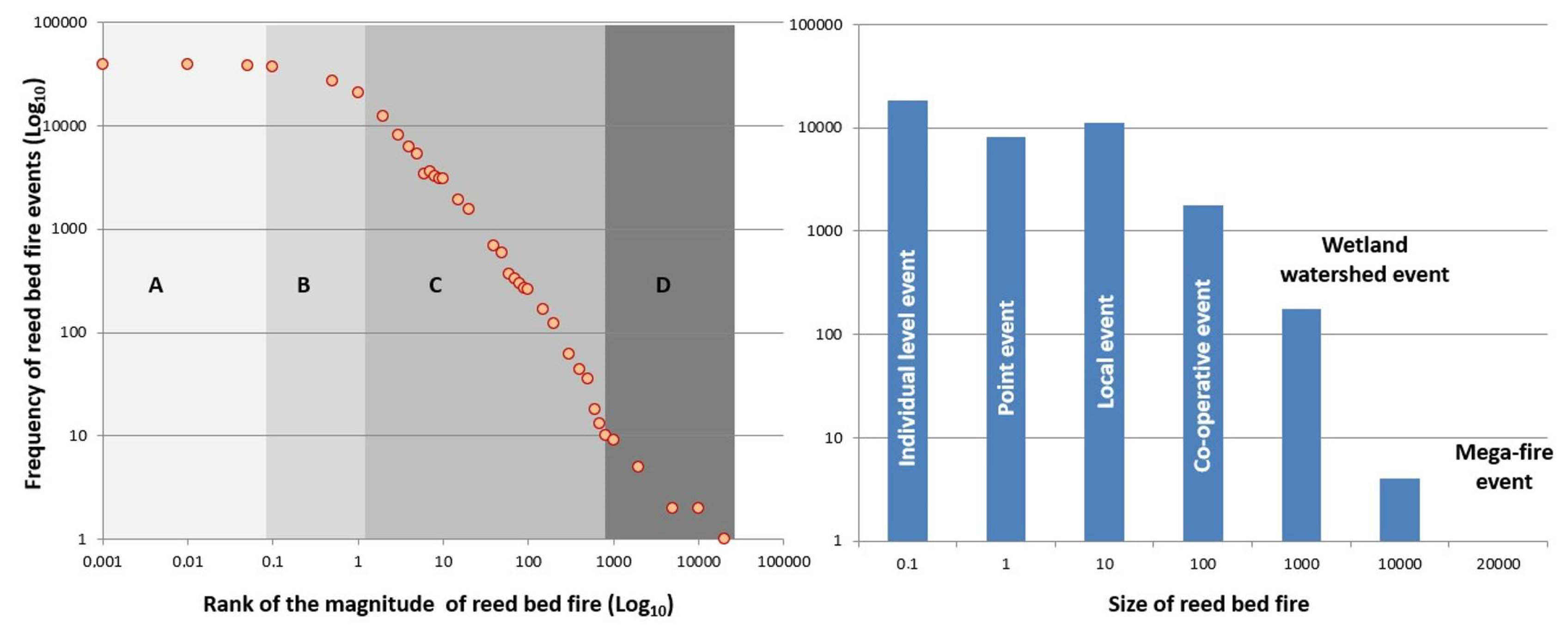
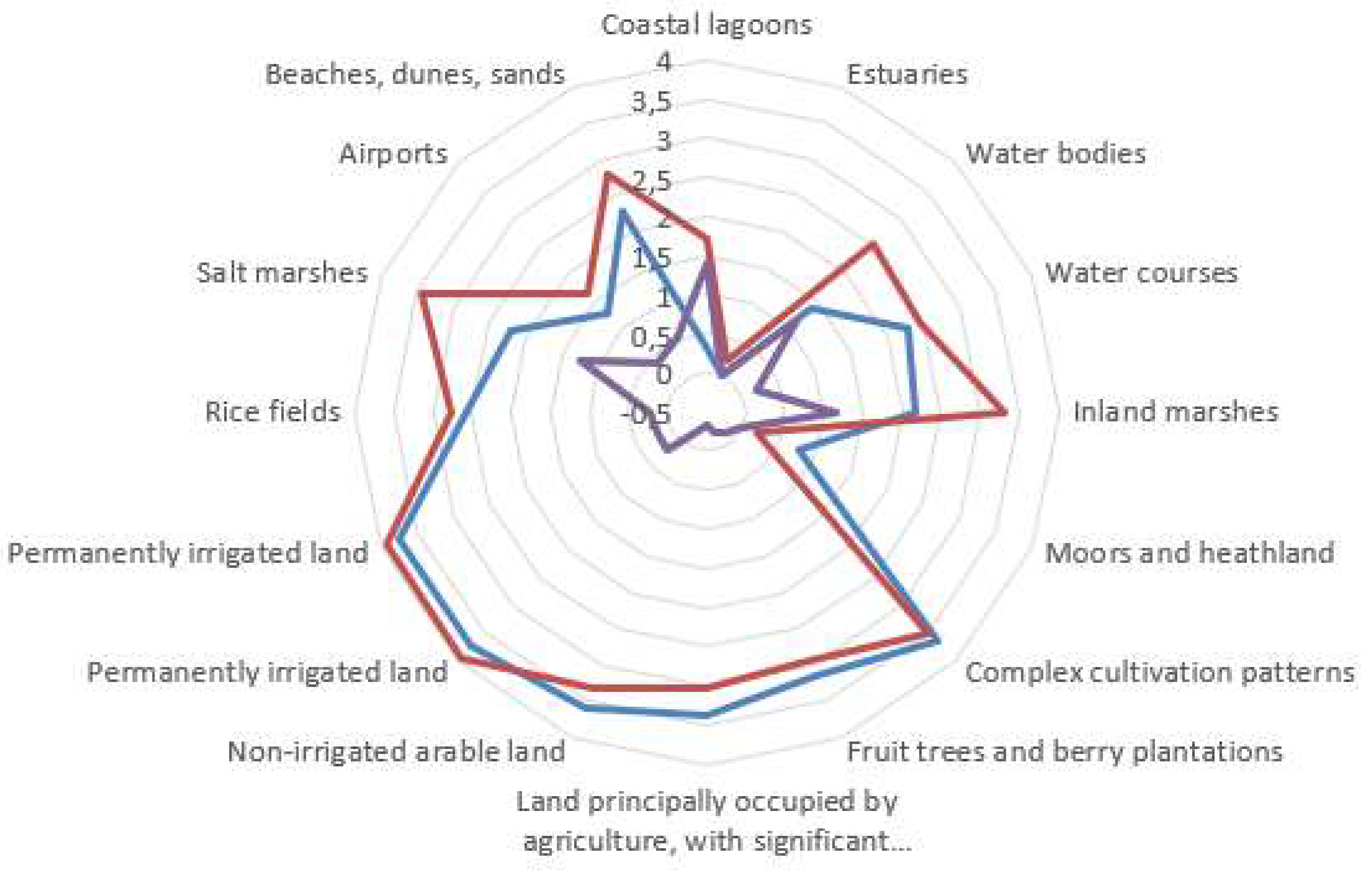
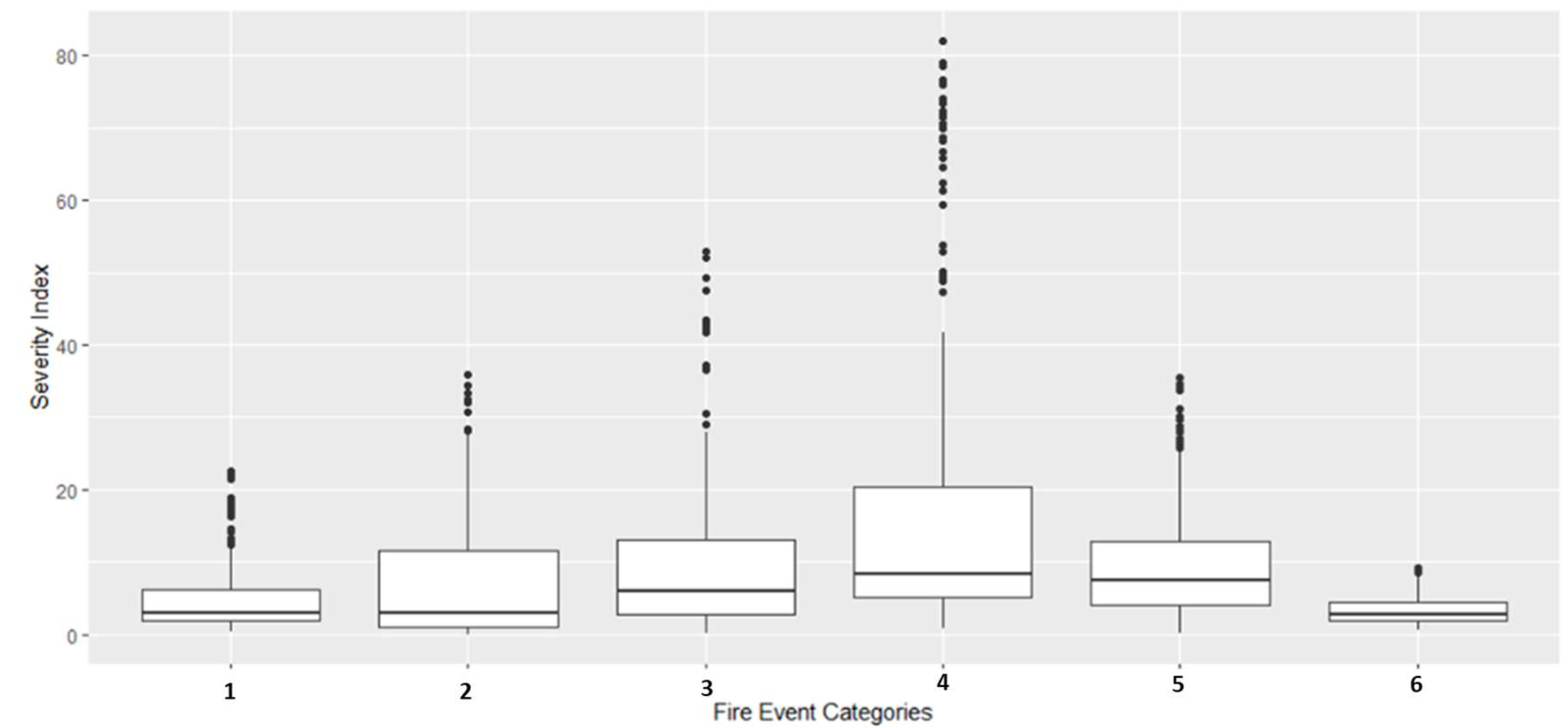

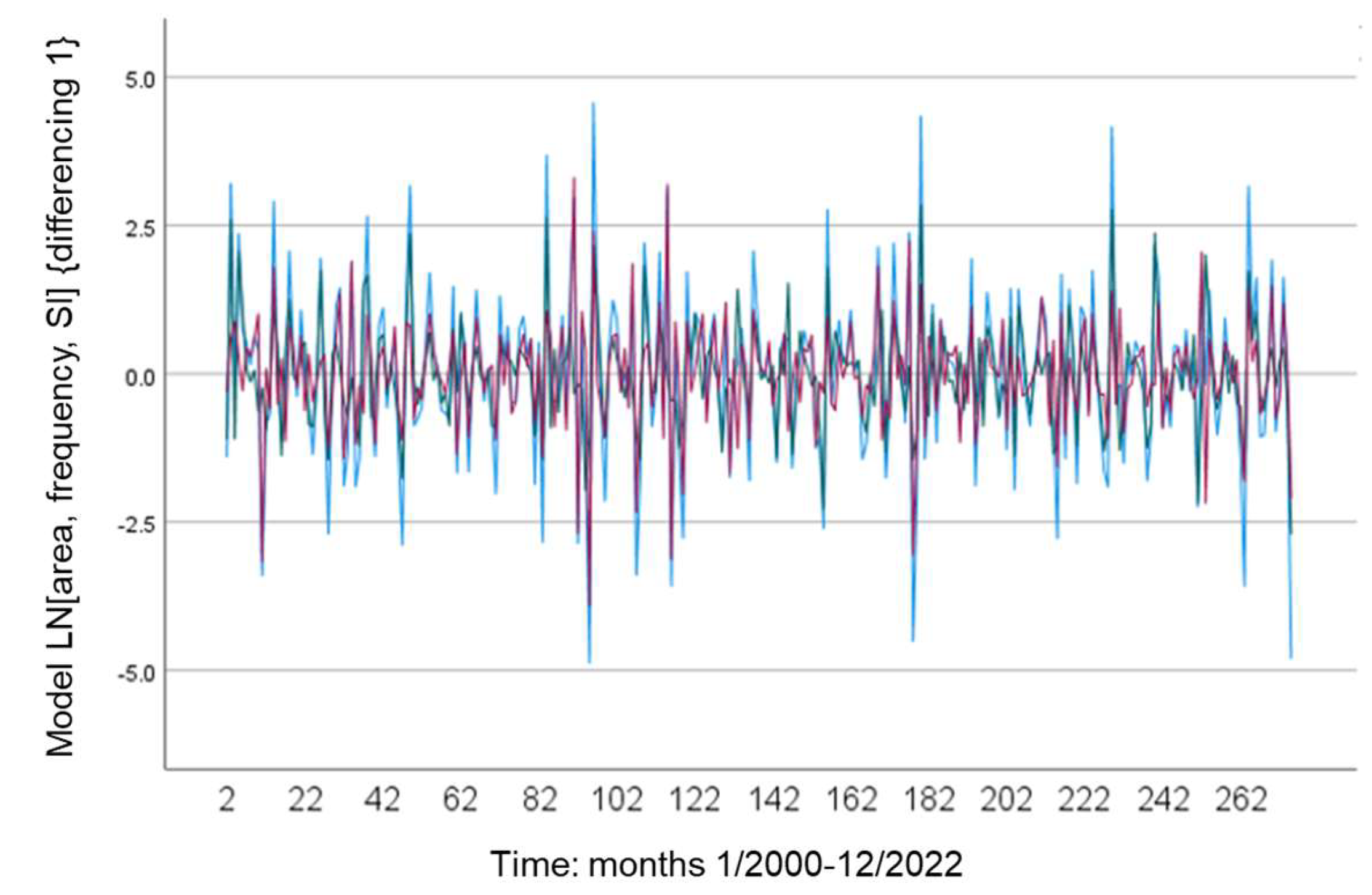
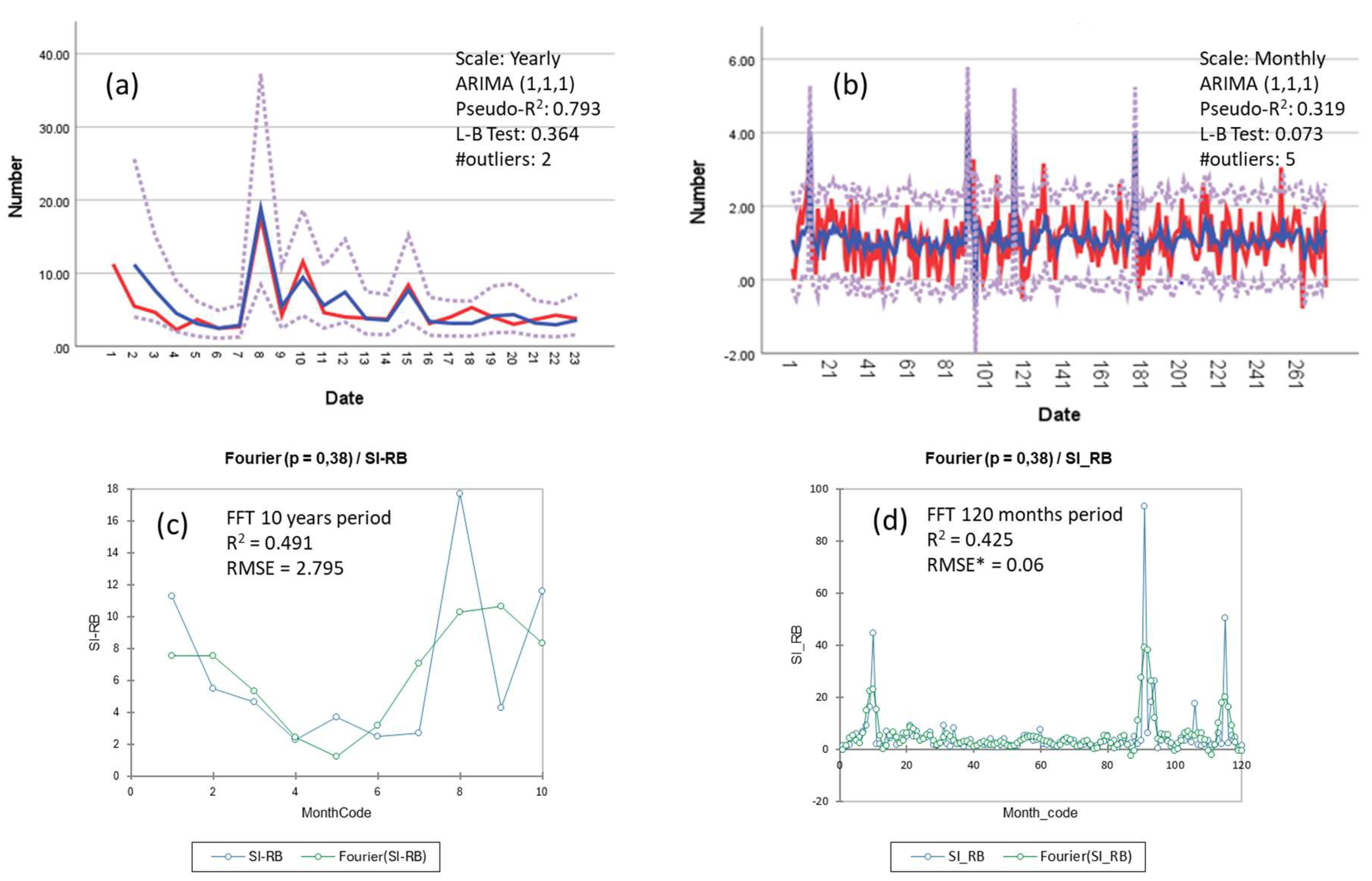


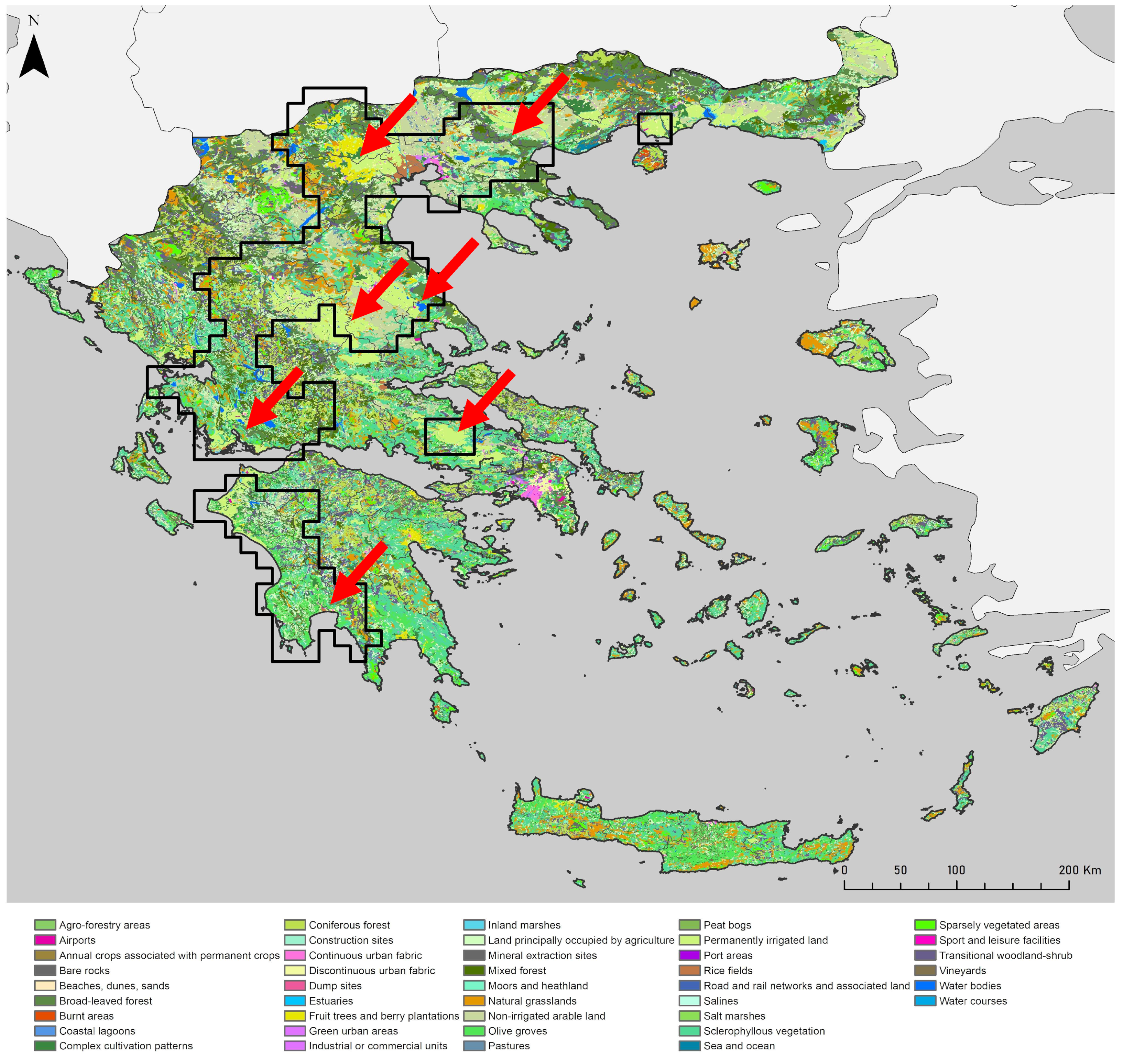
| Category of Information | Class | Unit |
|---|---|---|
| Time | Year | 20XX |
| Date, time of fire ignition | dd/mm, xx:xx | |
| Date, time of fire suppression | dd/mm, xx:xx | |
| Location | Prefecture (NUTS 3) | Name |
| Community | Name | |
| Specific location name | Name | |
| Geographical coordinates | (from 2020 to) | |
| Vegetation Type | Forest | Burned area in stremmas (1 stremma = 0.1 ha) |
| Forested areas | ||
| Shrubland–grassland | ||
| Urban–periurban groves | ||
| Agricultural burnings | ||
| Reed bed burnings | ||
| Uncontrolled dumpsites | ||
| General/Miscellaneous Information | Code number of the fire event | X |
| Means and personnel engaged | # airborne/terrestrial means, # personnel (firefighters, volunteers, military) |
| Major Land Reclamation—Wetland Drainage Works in Greece | |||||
|---|---|---|---|---|---|
| Drainage Work | Code | Period | Area (Stremma) | Prefecture or Region | Ecosystem Type |
| Kopaida | 1 | 1880–1886 | 250,000 | Viotia, Central Greece | Lake |
| Pamisos | 2 | 1888–1970 | 15,000 | Messynia, Peloponese | River |
| Karditsa | 3 | 1931–1959 | 1,090,000 | Thessalia | Marshes |
| Larisa (Karla) | 4 | 1931–1960 | 660,000 | Thessalia | Lake |
| Yiannitsa | 5 | 1928–1932 | 1,054,000 | Macedonia | Lake–marshes |
| Ahinos | 6 | 1930–1933 | 100,000 | Serres | Lake |
| Messologi | 7 | 1959–1969 | 105,000 | Aetolia-Acarnania | Lagoon |
| Time Scale/Data Series | Sample Size/Spatial Scale | ARIMA Model | White Noise | ||||||
|---|---|---|---|---|---|---|---|---|---|
| Non-Seasonal (p,1,q) | Seasonal (P,1, Q) | Fisher’s K | FFT RMSE* | ||||||
| Pseudo-R2 | RMSE | L-B Test | Pseudo-R2 | RMSE | L-B Test | ||||
| Monthly/SI reed bed burnings | 276/NUTS 3 | (1,1,1) 0.319 | (1,1,1) 0.635 | (1,1,1) 0.073 | (1,1,1)(1,1,2) 0.192 | (1,1,1) (1,1,2) 8.6 | (1,1,1) (1,1,2) 0.705 | p = 0.036 | p = 0.102 |
| Yearly/SI reed bed burnings | 2/NUTS 0 | (1,1,1) 0.793 | (1,1,1) 2.12 | (1,1,1) 0.364 | - | p = 0.403 | p = 0.052 | ||
| (3,1,3) 0.731 | (3,1,3) 2.64 | (3,1,3) 0.465 | |||||||
Disclaimer/Publisher’s Note: The statements, opinions and data contained in all publications are solely those of the individual author(s) and contributor(s) and not of MDPI and/or the editor(s). MDPI and/or the editor(s) disclaim responsibility for any injury to people or property resulting from any ideas, methods, instructions or products referred to in the content. |
© 2024 by the authors. Licensee MDPI, Basel, Switzerland. This article is an open access article distributed under the terms and conditions of the Creative Commons Attribution (CC BY) license (https://creativecommons.org/licenses/by/4.0/).
Share and Cite
Gaganis, C.M.; Troumbis, A.Y.; Kontos, T. Leveraging Reed Bed Burnings as Indicators of Wetland Conversion in Modern Greece. Land 2024, 13, 538. https://doi.org/10.3390/land13040538
Gaganis CM, Troumbis AY, Kontos T. Leveraging Reed Bed Burnings as Indicators of Wetland Conversion in Modern Greece. Land. 2024; 13(4):538. https://doi.org/10.3390/land13040538
Chicago/Turabian StyleGaganis, Cleo Maria, Andreas Y. Troumbis, and Themistoklis Kontos. 2024. "Leveraging Reed Bed Burnings as Indicators of Wetland Conversion in Modern Greece" Land 13, no. 4: 538. https://doi.org/10.3390/land13040538





